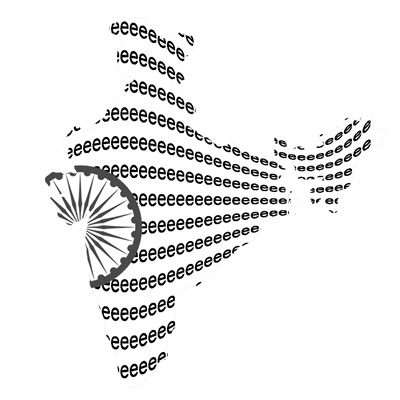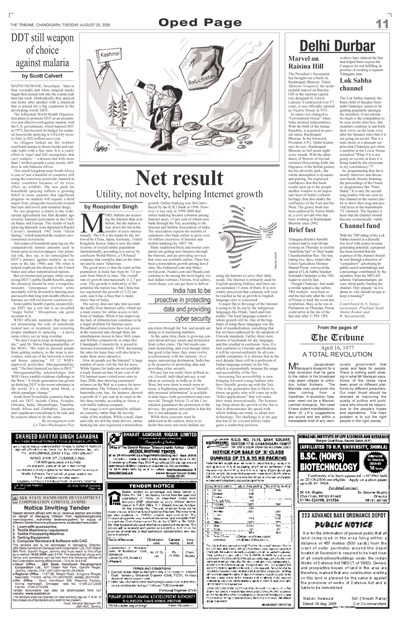Net result
Utility, not novelty, helping Internet growth
by Roopinder Singh

MORE Indians are accessing the Internet than ever before, but the nation is way down the list in the number of users internationally. The US is the leader by far, followed by China, Japan, Germany, United Kingdom, Korea. India is now the ninth in terms of overall online population internationally, according to a survey by comScore World Metrix, a US-based company that compiles data on the Internet and its users’ behaviour.
The good news is that the total online population in India has risen by 7.8 per cent from March to June. The overall rate of growth internationally is 2.7 per cent. This growth is indicative of the potential the nation has, but China has too registered the growth of 5.22 per cent, and it has a base that is many times that of India.
The survey does not take into account the traffic from Internet cafes, which are a main source for online access to millions of Indians. While it has improved, the lack of infrastructure continues to be a major problem for Internet users. Broadband connections have not grown at the expected rate, though there are simultaneous moves to have Wifi zones and WiMax connectivity in cities like Chandigarh. Connectivity is poised to increase tremendously. VSNL decreasing the rates for lease lines will also help to make them more attractive.
How do people use the Internet? A large number of users visit the Net for news. While figures for India are not available, a study found out that 54 per cent of all US Internet users visited news sites in June 2006, thus showing consumers’ reliance on the Web as a source for news information. The Tribune’s website, tribuneindia.com, has, for instance, showed a growth of 11 per cent in its reach in the last three months, according to Alexa, a web traffic ranking company.
Net usage is now governed by utilitarian concerns, rather than the novelty value of the medium. While e-mail, chats and calls are still the main drivers, online banking has also registered a tremendous growth. Online banking was first introduced by the ICICI Bank in 1996. However, it was only in 1999-2000 that online banking became common among Internet users, 15 per cent of whom now bank through the Net, according to the Internet and Mobile Association of India. The association expects the number of customers who bank online to grow over 16 million (inclusive of Internet and mobile banking) by 2007-’08.
Many traditional brick and mortar companies are getting new business through the Internet, and are providing services that were not available earlier. There has been a tremendous growth among travel sites, like Indianrail.com and Makemytrip.com. Naukri.com and Shaadi.com continue to be among the most highly visited Indian websites. Florists, fruit sellers, sweet shops, you can get them to deliver anywhere through the Net, and people are doing so in increasing numbers.
At the same time, there is growing concern about privacy issues and protection from cyber crime. The Net needs constant monitoring, and even though India has good cyber laws, they must evolve synchronously with the industry. As a major outsourcing destination, India has to be proactive in protecting data and providing cyber security.
Privacy has not really been defined as yet. Overall, individual privacy is not taken as seriously in India as in the West, but now there is much more to loose, a frightening amount of “identifiable personal information” is available in data bases, both government and commercial. Though Article 21 of the Constitution guarantees the protection of the privacy, the general perception is that the law is not adequate as yet.
While these concerns must be addressed at the earliest, there is no doubt that more and more Indians are using the Internet to serve their daily needs. The Internet is primarily used by English-speaking Indians, and there are an estimated 15 crore of them. It is now widely perceived that a plateau will soon be reached as far as growth in English language sites is concerned.
A major flip to the usage of the Internet is going to be its use by the indigenous languages like Hindi, Tamil and Gurmukhi. The local language content is where growth will be. One of the bugbears of using these languages was the lack of standardisation, something that has not been addressed by the adoption of Unicode standards. Earlier, there were dozens of keyboards for any language, and this resulted in confusion. Now, if a font conforms to Unicode specifications, it will be viewed uniformly by all compatible computers. It is obvious that in the next decade, there will be a profusion of Indian language content on the Net, which is exponentially increase the usage and accessibility of the Net.
Increasing Net accessibility is now bringing forward young Indians who have literally grown up with the Net. This is the generation that is likely to throw up geeks who will come up with “killer applications” that will make their mark internationally. The heartening thing about the growth of the Net is that it demonstrates the speed with which Indians are ready to adopt new technology. The challenge is in the gap that has to be covered before India gains a leadership position.

